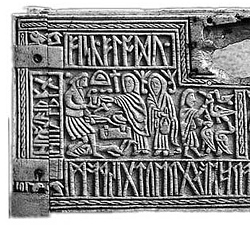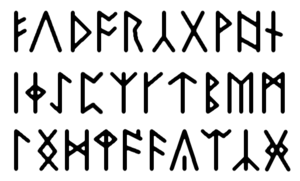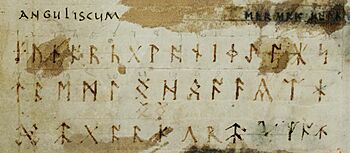Anglo-Saxon runes facts for kids
Quick facts for kids Futhorc |
|
|---|---|
| Type | Alphabet |
| Spoken languages | Anglo-Frisian (Old English and Old Frisian) |
| Time period | 5th through 11th centuries |
| Parent systems |
Egyptian hieroglyphs
|
| Sister systems | Younger Futhark |
| Note: This page may contain IPA phonetic symbols in Unicode. | |
The Anglo-Saxon runes are special letters used by the Anglo-Saxons and Frisians long ago. These groups are sometimes called Anglo-Frisians. They used these runes as their own alphabet to write in Old English and Old Frisian.
Today, this set of runes is known as the futhorc. This name comes from the sounds of its first six runes: ᚠ (f), ᚢ (u), ᚦ (th), ᚩ (o), ᚱ (r), and ᚳ (c). The futhorc grew from an older, 24-letter runic alphabet called Elder Futhark. The futhorc started with 28 letters and later grew to 34 letters. In other places, like Scandinavia, the Elder Futhark became a shorter 16-letter alphabet called Younger Futhark.
People likely started using Anglo-Frisian runes around the 5th century. They continued to use them into the High Middle Ages, which was a time period from about 1000 to 1250 AD. Later, the Old English Latin alphabet was brought to England by missionaries and slowly took over. By the 11th century, futhorc runes were not commonly used anymore. However, some old writings show that people still understood them until at least the 12th century.
Contents
History of Futhorc
There are different ideas about where the Anglo-Saxon futhorc came from. One idea is that it began in a place called Frisia and then spread to Britain. Another idea is that runes first came to Britain from the mainland. Then, they were changed in Britain and later sent back to Frisia. Both ideas have some weak points, so we might need more old objects found by archaeologists to know for sure.

The early futhorc was very similar to the Elder Futhark. But one big change was that the 'a' rune (ᚨ) was split into three new runes: ᚪ (āc), ᚫ (æsc), and ᚩ (ōs). This change helped to show new sounds that were developing in the language. The oldest known example of the ᚩ (ōs) rune might be from the 5th century. The ᚪ (āc) rune first appeared around the 6th century.
In England, the use of futhorc grew. By the 7th century, runic writing became connected with Latin writing, especially after Anglo-Saxons became Christian. Sometimes, texts were written using Latin letters, but with runes like þorn (þ) and ƿynn (ƿ) added to the Latin alphabet. After the Norman Conquest in 1066, runes became very rare. They disappeared completely a few centuries later. Even though they were used for at least 500 years, fewer than 200 objects with futhorc writing have survived.
Some famous English objects mix runes and Roman letters, or Old English and Latin. Examples include the Franks Casket and St Cuthbert's coffin. In the coffin, three names of the Four Evangelists are written in Latin using runes, but "LUKAS" (Saint Luke) is written in Roman letters. This shows that runes were used even by the church. Experts like Raymond Ian Page say that runes were not mainly linked to old pagan beliefs or magic after England became Christian.
Futhorc Letters
The order and number of letters in futhorc, and how they sounded, could change depending on the place and time. So, there isn't one perfect list of all the runes.
Rune List
Here is a list of some Anglo-Saxon runes, their names, what their names mean, and how they were written.
| Image | Unicode | Name | Name meaning | How it sounds |
|---|---|---|---|---|
| ᚠ | feh (feoh) | wealth, cattle | f | |
| ᚢ | ur (ūr) | aurochs (a type of wild ox) | u | |
| ᚦ | ðorn (þorn) | thorn | th | |
| ᚩ | os (ōs) | heathen god (or mouth) | o | |
| ᚱ | rada (rād) | riding | r | |
| ᚳ | cen (cēn) | torch | c | |
| ᚷ | geofu (gyfu) | gift | g | |
| ᚹ | wyn (wynn) | mirth (joy) | w | |
| ᚻ | hægil (hægl) | hail | h | |
| ᚾ | næd (nēod) | plight (difficulty) | n | |
| ᛁ | is (īs) | ice | i | |
| ᛡ / ᛄ | gær (gēar) | year | j | |
| ᛇ | ih (īw) | yew tree | ï | |
| ᛈ | peord (peorð) | (meaning unknown) | p | |
| ᛉ | ilcs (eolh?) | (meaning unknown, maybe related to elk) | x | |
| ᛋ / ᚴ | sygil (sigel) | sun (or sail) | s | |
| ᛏ | ti (Tīw) | (meaning unknown, originally god) | t | |
| ᛒ | berc (beorc) | birch tree | b | |
| ᛖ | eh (eh) | steed (horse) | e | |
| ᛗ | mon (mann) | man | m | |
| ᛚ | lagu (lagu) | body of water (lake) | l | |
| ᛝ | ing (ing) | Ing (a god) | ng | |
| ᛟ | oedil (ēðel) | inherited land, native country | œ | |
| ᛞ | dæg (dæg) | day | d | |
| ᚪ | ac (āc) | oak tree | a | |
| ᚫ | æsc (æsc) | ash tree | æ | |
| ᛠ | ear (ēar) | (meaning unknown, perhaps earth) | ea | |
| ᚣ | yr (ȳr) | (meaning unknown, perhaps bow) | y |
The order of these runes is mostly based on an old book called Codex Vindobonensis 795. However, the order and names of runes could be different in other old writings. For example, the names ing and æsc come from a different manuscript.
Rune Combinations
Sometimes, runes were combined to make new sounds or to fit into small spaces. These are called combinations or digraphs. Here are a few examples:
| Combination | Sound | Example Word | Meaning | Found on |
|---|---|---|---|---|
| ᚩᛁ | oi | ]oin[.] | (unknown) | Lindisfarne Stone II |
| ᚷᚳ | gg, dj | blagcmon | (personal name) | Maughold Stone I |
| ᚷᚷ | dj | eggbrect | (personal name) | Galloway Hoard armband |
| ᚻᚹ | wh | gehwelc | each | Honington Clip |
| ᚻᛋ | ks | wohs | to wax | Brandon Antler |
| ᚾᚷ | ng | hring | ring | Wheatley Hill Silver-Gilt Finger-Ring |
| ᛁᚷ | ij | modig | proud/bold/arrogant | Ruthwell Cross |
| ᛇᛡ? | ij | hælïj? | holy? | Gandersheim Casket |
| ᛇᛋ | ks | BennaREïs | king Benna | (a coin) |
| ᛋᚳ | sk, sh | fisc | fish | Franks Casket |
| ᛖᚩ | eo | eoh | (personal name) | Kirkheaton Stone |
| ᛖᚷ | ej | legdun | laid | Ruthwell Cross |
| ᛖᛇ | ej | eateïnne | (personal name) | Thornhill Stone II |
| ᛖᚪ | ea | eadbald | (personal name) | Santi Marcellino e Pietro al Laterano Graffiti |
| ᚪᚢ | au | saule | soul | Thornhill Stone III |
| ᚪᛁ | ai | aib | (personal name) | Oostum Comb |
| ᚪᛡ | aj, ax | fajhild? faghild? | (personal name) | Santi Marcellino e Pietro ad Duas Lauros Graffiti |
| ᚫᚢ | au | dæus | deus (Latin for god) | Whitby Comb |
| ᚫᚪ | ea | æadan | (personal name) | Mortain Casket |
How Runes Were Used
In Old English, a rune could be called a rūnstæf, which might mean "mystery letter" or "whisper letter". Sometimes, it was just called rūn.
Futhorc writings come in many styles. Some old runestones even show traces of paint, meaning the runes were once colored. Sometimes, runes were joined together, called Bind runes. This was often done to make the writing fit in a small space. Runes were also used as symbols for words, where a rune stood for its name or a similar-sounding word. For example, in the famous poem Beowulf, the ēðel rune was used to mean "homeland". Some old writings also show that people used secret codes with runes. In one old book, runes were even used like Roman numerals to show numbers.
There is some evidence that futhorc runes were used for magic. For example, a special rune sequence called alu (which might have been magical) was found on an urn. In an old story by Bede, a man named Imma could not be tied up by his captors. They asked if he was using "loosening letters" to break free. In an Old English version of this story, they asked if he was using "magic" or "runestaves" to break his bonds. Also, some rings have been found with what seem to be magical writings meant to stop bleeding.
Where Runes Were Found
Experts are collecting all the known Old English and Old Frisian runic writings into a database. This helps them study these old texts.
There are fewer than 200 objects with futhorc writing. This is a bit more than the older Elder Futhark runes found in Europe, but less than the Elder Futhark runes found in Scandinavia.
Runic finds in England are mostly along the east coast, with a few found further inland in Southern England. Frisian finds are mostly in West Frisia.
Here are some examples of where Anglo-Frisian runes have been found:
- Frisian finds: Combs, coins, sword handles, and sticks.
- English finds: Sword parts, brooches, urns, coins, a coffin, the Franks casket, the Ruthwell Cross, and rings.
Related Old Writings
Many old books and manuscripts help us understand futhorc runes. These include:
- Codex Sangallensis 270 – This book lists runes and their names, and explains how to use rune codes.
- Codex Sangallensis 878 – This book shows Anglo-Saxon runes.
- Codex Vindobonensis 795 – This book describes Anglo-Saxon runes.
- Cotton Domitian A.IX – This book lists runes with their names.
- Cotton Otho B.x.165 – This book contained the Old English rune poem before it was damaged in a fire.
- Cotton Vitellius A.XII – This book lists runes in alphabetical order.
See Also
 In Spanish: Futhorc para niños
In Spanish: Futhorc para niños
- Elder Futhark
- List of runestones
- Ogham
- Old English Latin alphabet
- Runic alphabet
- Younger Futhark
Images for kids
-
The Futhorc series on the Seax of Beagnoth (9th century).











